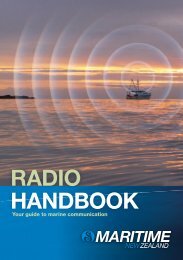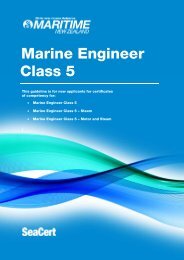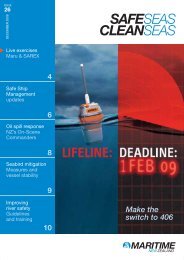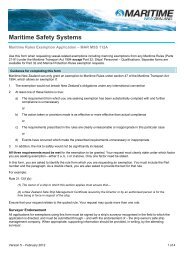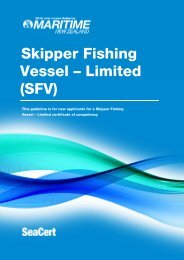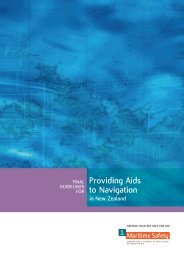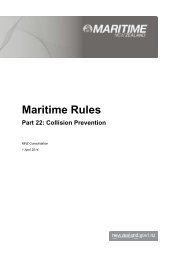Create successful ePaper yourself
Turn your PDF publications into a flip-book with our unique Google optimized e-Paper software.
Throttlefailure offthe rocks TheA harbour cruise vesselwith 31 passengers on boardwas manoeuvring just50 metres from shore whenthe throttle failed.As the skipper put both enginesastern to allow passengers to get abetter view of some seals, only the portengine responded. The starboard enginecontinued to idle ahead. When the skipperre-engaged the starboard engine toastern, the vessel leapt forward with fullahead power on the starboard engine. Asthe skipper tried unsuccessfully to turnthe vessel away from the shore using fullport throttle, it impacted on a rock ledge.1. The control Morse cables werereplaced with a more robust cable.Emergency stop buttons were alsoinstalled on each bridge wing.The skipper hit the emergency stop onthe starboard engine and moved thebow off the rock using the port engine.As he did so, the vessel’s stern quartersmacked onto the rocks.Aided by a light breeze and theswell, the skipper freed the vessel andpositioned it in clear water. The voidspaces were inspected, and no waterwas found. Throughout the slow tripback to port, the skipper repeatedlychecked the vessel to ensure it wasnot taking on water.The passengers were shaken, butthere were no serious injuries and nonewere admitted to hospital.On investigation, metallurgists found2. It is possible to reduce stress on gearcable by supporting it horizontally forabout 100 to 150 mm from the actuatorbox cable fastening. Securely clampingMorse cables at least 100 mm past theWhen the skipperre-engaged thestarboard engine toastern, the vesselleapt forward withfull ahead powertop left: the vessel. above: the Damaged starboard propeller.the throttle failure was due to a brokengear-select Morse cable. It had brokendue to metal fatigue caused by cyclicunidirectional bending when the gearwas operated.The vessel sustained damage tothe starboard hull, the starboard propellerand shaft.View the full report online at:www.maritimenz.govt.nzLookout!Pointsfastening will ensure the filament doesnot rub against the outer sheath andwill minimise metal fatigue. The vessel’sowner installed a system after the accidentto reduce unidirectional bending.Simplewatertightcommunicationscan save livesA cellphone may have saved the life of arecreational boatie who died after a lateafternoon fishing jaunt, but only if it wassealed in a plastic bag. The boatie andthe skipper of a small aluminium dinghyhad left a cellphone in their car at theboat ramp.When the pair was about one milefrom shore, travelling at approximately15 knots, the skipper let go of theoutboard motor tiller to stop his hat fromblowing off in the wind. At this point thedinghy went into a tight spin, partiallyswamping it, which resulted in the dinghycapsizing before the men had a chanceto bail it out. Neither man had been wearinga life jacket, but both managed toput these on after being thrown into thewater. They then made several attemptsto right the upturned dinghy, but it provedtoo unstable with the stern held down bythe weight of the outboard motor.With night approaching, the tidecarrying them further from land and noother boats in sight, the pair decided toswim for shore.The men saw some fishing buoys thatwere significantly closer than the shore1. The area where the men were fishinghad both VHF radio and cellphone coverage.A water-resistant, hand-held VHFradio costs under $200 and will not onlyalert <strong>Maritime</strong> Radio right around the NZcoast, but can also summon help fromother vessels within at least a four-mileradius. A cellphone in a sealed plasticbag can be used effectively with no lossThe dinghy.and decided to make for them. Althoughboth were good swimmers, the tide wasagainst them and they were unable toreach the buoys. After an hour, one manbecame exhausted.skipper then faced the agonisingchoice of staying with his exhausted friendor pressing on for shore and help.The skipper then faced the agonisingchoice of staying with his exhaustedfriend or pressing on for shore and help.For two hours, the skipper attemptedto tow his friend, but finally made thedecision to swim on alone. It took him afurther two hours to reach the shore andraise the alarm at a local farm house.Just over an hour later, the rescuehelicopter sighted the upturned dinghy.of reception quality.2. The area was visible from shore byseveral houses and a road. A red, handheldflare may well have been seen.3. A personal locator beacon would alsohave raised the alarm.4. Capsizes are not uncommon in smallboats. Boaties need to be prepared andhave an action plan to cope with anyThe missing man was found minuteslater by the Coastguard in a very seriouscondition. He was pronounced deadshortly after reaching shore.The following information is availableonline at www.maritimenz.govt.nzor by phoning 0508 22 55 22:<strong>Maritime</strong> Rule Part 91.4 – NavigationSafety Rules: Personal Floatation DevicesSafe Boating An Essential Guidepublished by <strong>Maritime</strong> NZ, Coastguardand Water Safety NZTips About Boating Safety stickerproduced by <strong>Maritime</strong> NZView the full report online at:www.maritimenz.govt.nzan example of A waterproof bagthat can be used for a cellphone.these are readily available frommost ship chandlers.Lookout!Pointsemergency. As both men had life jacketsand were sound swimmers, a meansof being able to communicate withsomeone ashore would almost certainlyhave prevented this accident leadingto a fatality.5. If the boat had not been equippedwith life jackets, it is probable that twolives would have been lost.10 LOOKOUT! JULY <strong>2006</strong>LOOKOUT! JULY <strong>2006</strong> 11





